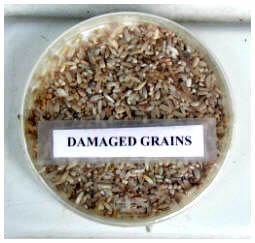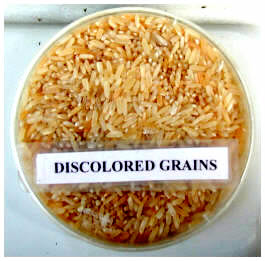Grain moisture content and grain quality
In post-harvest handling, grain moisture content is generally stated on a wet weight basis (MCwb). This means that it is expressed as percentage of water contained in the wet grain.
Improper drying and storage practices lead to low grain or seed quality.
Some problems related to incomplete or untimely drying or storage of paddy with high moisture content are:

Heat build up in the grain
Natural respiration of stored, wet grain will generate heat, in particular when it is stored in sacks in bulk. Heat will provide excellent growth conditions for molds, insects and deteriorate quality.
Mold development
Molding of grain propagates diseases in the grain and may release toxins into the grain. Although some fungi causing the molds may be present in the grain at harvest time, safe moisture content can reduce further development of these molds. If the fungi are of the mycotoxin-producing family, rice is unsafe for nourishment and might be totally unusable for food or livestock feed purposes.
Insect infestation
Insect infestation is always a problem in stored grain in tropical climates, even if the grain is completely dried. However, the less moisture in the grain, the fewer the expected insect problems. A combination of proper drying procedures and storage practices, including storage hygiene, will keep insect infestation at acceptable levels.
 Discoloration/Yellowing
Discoloration/Yellowing
A general yellowing of the rice grain is a result of heat build up in the paddy grain before drying. Discolored grain drastically reduces the market value of rice since whiteness is an important quality characteristic for rice consumers. Although discoloration is a complex biochemical process, it can be easily avoided by timely drying of paddy after harvest.
Loss of germination and vigor
Moisture in grain will gradually reduce germination ability of the seed during storage. Active respiration of the grain during storage will deplete the nutrition reserves that the seed uses to germinate or sprout. Molds and diseases can also reduce the ability of the seed to germinate. The lower the moisture content of seed at the beginning of storage, the longer the seed remains viable.
Loss of freshness/odor development
Deterioration of quality or aging of stored rice results from a combination of a change in the chemical components (increase in fatty acids and decrease in sugars) and changes of rice kernel characteristics (such as kernel hardness). Heat build up in the grain (above 55ºC) due to insects, molds or high humidity will often lead to a musty odor in rice. Therefore, rice stored for longer periods under adverse conditions (high grain moisture content and/or high temperatures) can develop odors which reduce the market value of rice considerably. In particular, molds (fungi) that grow on rice can produce offensive odors due to deterioration of chemical components in the rice. If the fungi are of the mycotoxin-producing family, rice is unsafe for nourishment and might be totally unusable for food or livestock feed purposes.
Reduced head rice yield
A major cause for fissuring of rice kernels is the moisture adsorption of individual dry grains with moisture contents below 16%. This can happen either when wet grain is mixed with dry grain (in storage, in the dryer or after drying in a batch dryer with a resulting moisture gradient) or when dry grain is exposed to humid ambient air with a relative humidity higher than the equilibrium relative humidity at the corresponding grain moisture content. Fissures in rice kernels usually lead to cracking of the grain during the milling process and thus reduce the head rice recovery.










